Tips From Sticks-In-The-Mud Woodshop
by Jim Randolph
Long Beach, Mississippi
Welcome to a new feature in Wood News Online, "Tips From Sticks-In-The-Mud Woodshop". I am a hobbyist, not a professional, someone who loves woodworking, just like you do. I have found some better ways to accomplish tasks in the workshop and look forward to sharing those with you each month, as well as hearing your problem-solving ideas.
Tip #1
I like to make furniture and other projects with the advance plan that they will become family heirlooms.
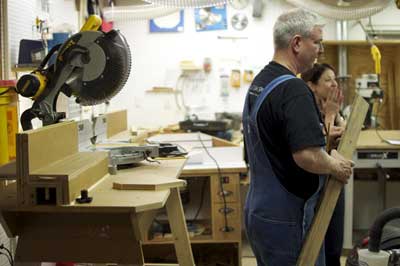
|
I chose this as my profile photo because it captures the response we
hope to receive to every piece we hope will become a family heirloom.
|
You already sign your work with burning, etching, CNC or hand router or Sharpie, and that will identify you as the artist. I go a step further and inject some "process" into each piece.
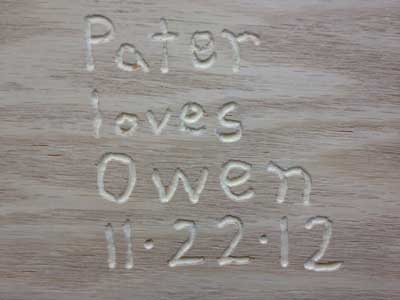
|
|
Signing and dating the woodworking gift is just the beginning.
|
It starts with a letter to the recipient in which I explain the purpose of the project, any history behind the wood used and interesting details about its design and construction.
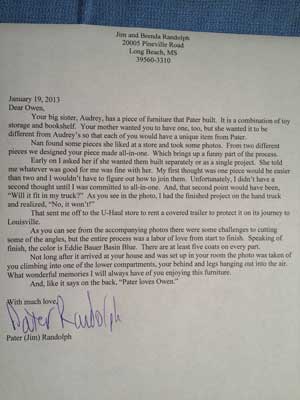
|
Someday a descendant might want to know more about
this item of furniture: Where did it come from? Who made it?
What is known about the artist? What was his studio/shop like?
Who was the first recipient?
|
With my handy iPhone, I take copious photographs as I work, many of which describe the steps, challenges and interesting occurrences along the way. If I made scale drawings and notes to myself along the way, they, too, help to tell the whole story of the piece.
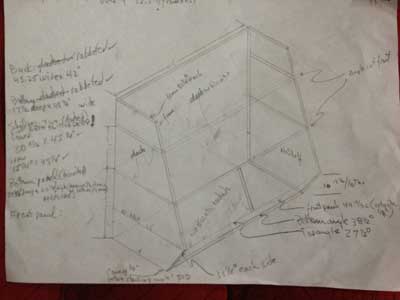
|
|
What steps went into the process? Whose ideas went into the design?
|
I even include scribbles and sketches to really capture the thought process.
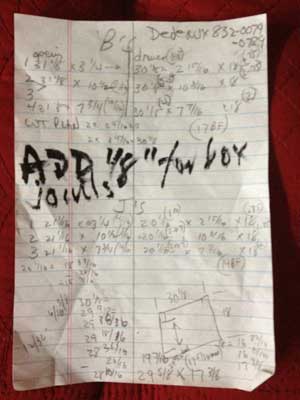
|
What was he thinking as he worked?
What challenges did he face?
Did he overcome them or change the
design to deal with those challenges?
Perhaps, even, What is a fraction?
|
To contain such a large amount of information the letter and photos are burned onto a DVD, which is then inserted into a DVD case, then into a zipper-lock bag stored in a drawer or attached to the back or underside of the piece.
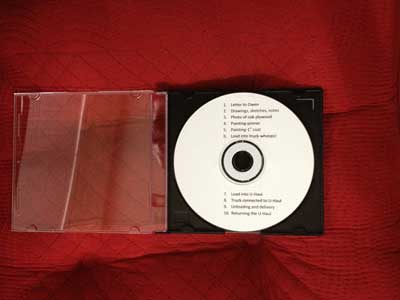
|
The capacity of a DVD-R is about 4.7 gigabytes, sufficient to hold several
thousand photographs, leaving plenty of room for a one, two or three
kilobyte letter, telling the whole story to the original recipient and his
descendants who may inherit the work.
|
For projects too small to house a DVD, it simply accompanies the item. Later generations will know more than just that Grandpa made the item, but so much more about who Grandpa was, how the piece came into existence and what his thought process was along the way.
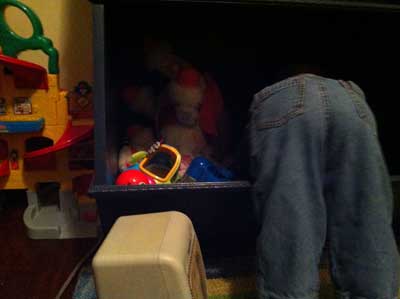
|
Even as our son and daughter-in-love discussed the original design we
envisioned Owen, the youngest grandson and recipient of the
bookcase/toy storage case, climbing into the bottom cubbies just like this.
A little more than a week passed before he figured out that's what they were for.
|
Tip #2
No Southern-fried Southern boy wants to be called a Yankee, but we share the characteristics of shrewdness and thrift. Thus, each month we include a money-saving tip. It's OK if you call me "cheap."
I have a drying rack for paper towels. All right, it's really the homemade PVC apron I built to surround my wife's clay-throwing wheel. You might be amazed to know how many times a paper towel can be reused. Once dry, they become rejuvenated.
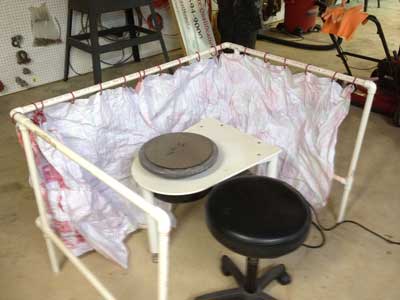
|
When Brenda is not slinging clay all over the part of the garage that serves as
her ceramic studio, this homemade apron apparatus serves as a drying rack
for my gently-used paper towels.
|
When they are too ragged to wipe your hands, you can still wipe up spilled paint or oil from the shop floor. It makes a great place to dry your Playtex gloves, too!
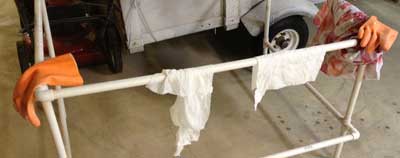
|
Because this PVC rack normally lives close to the sink anyway, it doesn’t take
up any extra space and remains close to Brenda’s clay wheel,
ready to change over to its original duty.
|
One limitation: I never put a used paper towel to use during the finishing process. Even cheapness is no reason to put a finish in jeopardy.
Jim Randolph is a veterinarian in Long Beach, Mississippi. His earlier careers as lawn mower, dairy farmer, automobile mechanic, microwave communications electronics instructor and journeyman carpenter all influence his approach to woodworking. His favorite projects are furniture built for his wife, Brenda, and for their children and grandchildren. His and Brenda’s home, nicknamed Sticks-In-The-Mud, is built on pilings (sticks) near the wetlands (mud) on a bayou off Jourdan River. His shop is in the lower level of their home. Questions and comments on woodworking may be sent to
DrRandolph@MyPetsDoctor.com
. Questions about pet care should be directed to his blog on pet care,
www.MyPetsDoctor.com
. We regret that, because of high volume, not all inquiries can be answered personally.
Return to
Wood News
front page


